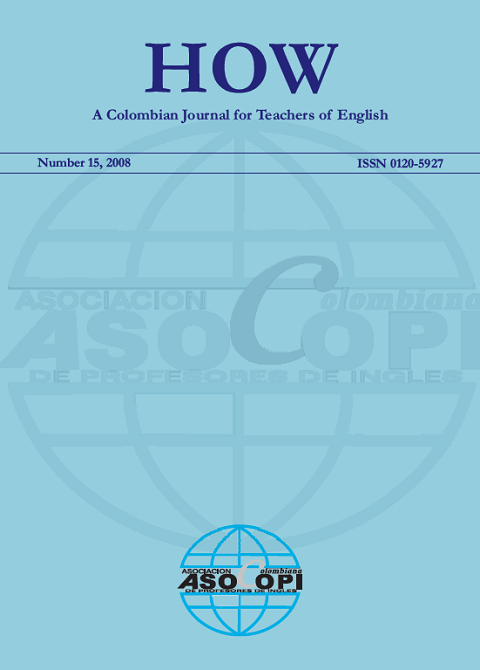Treating ESL Writing Errors: Balancing Form and Content
Main Article Content
Abstract
The general acceptance of Communicative Language Teaching has generated confusion with respect to the role of writing in the ESL curriculum, the usefulness of ESL writing error treatment, and the form that treatment should take. An imaginary conflict between the goals of encouraging students’ communicative use of L2 and that of promoting formal correctness often discourages ESL teachers from dealing with writing errors that may be easily treatable during early stages of learning but which, left untreated, continue to affect students’ performance at much higher academic levels. By careful application of appropriate techniques, teachers can provide error treatment while promoting habits of self monitoring, revision, and autonomy.
Article Details

This work is licensed under a Creative Commons Attribution-NonCommercial-NoDerivatives 4.0 International License.
The authors of the manuscripts accepted for publication in HOW journal are required to sign a nonexclusive license agreement allowing ASOCOPI to reproduce the full text on the Internet or in any other available source. Authors retain copyright of their manuscripts with the following restrictions: first publication is granted to ASOCOPI; nonexclusive agreements with third parties can be established as long as the original publication in the HOW journal is properly acknowledged.
References
Allwright, D., & Bailey, K. M. (1991). Focus on the language classroom. Cambridge, U.K.: Cambridge University Press.
Bloomfield, L. (1933). Language. Chicago: University of Chicago Press.
Brown, H. D. (2000). Principles of language learning and teaching (4th ed.). New York: Longman.
Chastain, K. (1976). Developing second language skills: Theory to practice (2nd ed.). Boston: Houghton Mifflin.
Corder, S. P. (1981). Error analysis and interlanguage. Oxford: Oxford University Press.
Crystal, D. (1987). The Cambridge encyclopedia of language. Cambridge: Cambridge University Press.
Cummins, J. (1999). Beyond adversarial discourse: Searching for common ground in the education of bilingual students. In C. J. Ovando & P. McLaren (Eds.), The politics of multiculturalism and bilingual education: Students and teachers caught in the cross-fire (pp. 126-147). Boston: McGraw-Hill.
Ellis, R. (1994). The study of second language acquisition. Oxford: Oxford University Press.
Gabrielatos, C. (1994). Minding our ps. Current Issues, 3, 5-8. Retrieved July 25, 2008, from http://www.gabrielatos.com/PPP.pdf
Gabrielatos, C. (2002). EFL writing: Product and process. (ERIC Document Reproduction Service No. ED476839). Retrieved December 16, 2008, from ERIC database.
Giraldo, M. C., & Perry, R. A. (2005). Treating writing errors of low-to-intermediate EFL university students. Unpublished master’s thesis, Universidad de Caldas, Colombia.
Gray, R. (2004). Grammar correction in ESL/EFL writing classes may not be effective. The TESL Journal, X (11). Retrieved July 25, 2008, from http://iteslj.org/Techniques/
Gray-WritingCorrection.html
Hodges, J. C., & Whitten, M. E. (1972). Harbrace college handbook (7th ed.). New York: Harcourt Brace Jovanovich.
Krashen, S., & Terrell, T. (1983). The natural approach: Language acquisition in the classroom. Hayward, CA: The Alemany Press.
Lyster, R., Lightbown, P. M., & Spada, N. (1999). A response to Truscott’s “What’s wrong with oral grammar correction”. Canadian Modern Language Review, 55 (4), 456-467.
Mahili, I. (1994). Responding to student writing. English Teaching Forum, 32 (4), 24-27.
Mantello, M. (1997). Error correction in the L2 classroom. Canadian Modern Language Review, 54 (1), 127-132.
Pakula, A. J. (Producer), & Mulligan, R. (Director). (1967). Up the down staircase [Motion picture]. U.S.A.: Warner Bros.
Porte, G. K. (1993). Mistakes, errors, and blank checks. English Teaching Forum, 31 (1), 42-44.
Quiroga, A., Jiménez, H., & Rojas, G. (2001). La enseñanza de la lengua materna en el Caquetá: Estado actual y alternativas de transformación. Florencia, Caquetá: Universidad de la Amazonía, Colciencias, BID.
Real Academia Española. (1973). Esbozo de una nueva gramática de la lengua española. Madrid: Espasa
Calpe. Reid, J. M. (1993). Teaching ESL writing. Englewood Cliffs, NJ: Prentice Hall.
Rivera, K. (1990). Developing native language literacy in language minority adults. Washington D.C.: National Clearinghouse on Literacy Education. (ERIC Document Reproduction Service No. ED358747). Retrieved July 25, 2008, from ERIC database.
Simpson, JoEllen. (2003). Responding to our students’ writing: what is good for us and for them? HOW, 2003 issue, Vol. 10, pp. 45-52
Truscott, J. (1999). What’s wrong with oral grammar correction. Canadian Modern Language Review, 55 (4). Retrieved August 6, 2005, from http://www.hss.nthu.edu.tw/~fl/faculty/John/What%27s%20Wrong%20with%20Oral%20Grammar%20Correction%201999.htm
Truss, L. (2003). Eats, shoots and leaves. The zero tolerance approach to punctuation. London, U.K.: Profile Books.
Wright, T. (1987). Roles of teachers and learners. Oxford: Oxford University Press.

